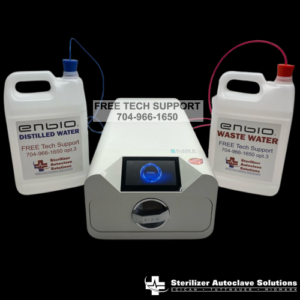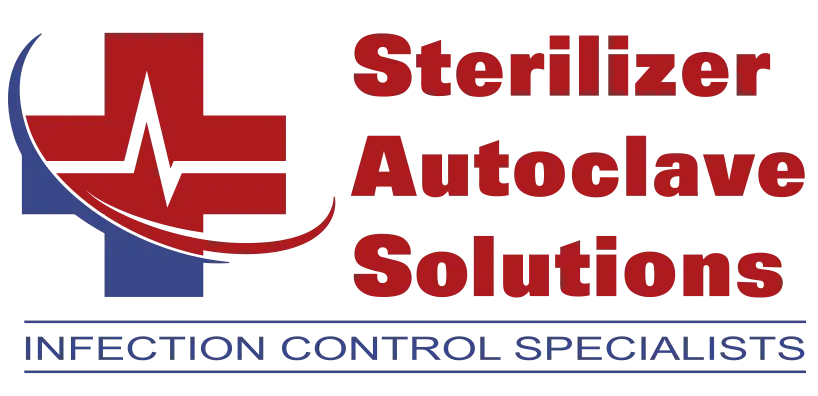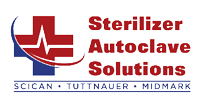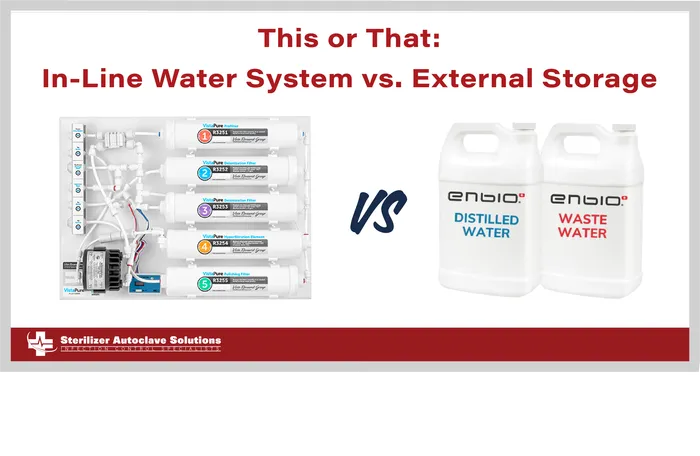This or That: In-Line Water Systems vs External Water Storage
Choosing the right water system for your autoclave is crucial for efficient and effective sterilization in any practice. Both in-line water systems and external water storage offer distinct advantages and disadvantages that impact workflow, cost, and overall convenience. Understanding these differences can help you make an informed decision for your facility’s needs.
So in this article, we’d like to go over the pros and cons of both in-line water purification systems and external water storage for autoclaves. We will also provide one of our popular examples for each so that you can get a better understanding.
What is an In-Line Water System?
One of the ways in which autoclaves get the water they need to properly sterilize, is through in-line water systems. As the name implies, in-line systems connect directly to the water line of the practice itself. The water is filtered through an external filtration system connected to the water system. Usually, in-line systems make their filtered water using deionization or reverse osmosis filters before it enters the reservoir of the autoclave.
It provides an automated and continuous water supply solution for autoclaves, ensuring that the machine always has a consistent flow of high-quality water for its sterilization cycles without human intervention for filling.
With that being said, let’s go over some of the pros and cons that come with the use of in-line water systems:
Pros:
- Convenience and Automation: These systems automatically draw water as needed, eliminating the need for manual filling. This saves staff time and reduces the risk of human error in ensuring consistent water levels.
- Continuous Supply: As they are directly connected to a treated water source (often reverse osmosis or distilled water systems), they provide a continuous and uninterrupted supply for repeated sterilization cycles.
- Reduced Handling and Contamination Risk: There’s no manual pouring or refilling of tanks, which minimizes opportunities for airborne contaminants to enter the water supply, promoting a cleaner operation.
- Space Saving: Without the need for large external water storage tanks, these systems can save valuable counter or floor space in reprocessing areas.
- Improved Water Quality Control: Many in-line systems integrate water purification units (like deionizers or RO systems) with real-time monitoring (e.g., TDS meters), ensuring a consistent supply of high-quality water directly to the autoclave, which extends equipment lifespan and ensures sterilization efficacy.
Cons:
- Initial Installation Cost and Complexity: Setting up an in-line system, especially if it includes a water purification unit, can involve higher initial costs for plumbing and equipment compared to a simple external tank setup.
- Reliance on Water Quality: While purification systems help, the effectiveness of an in-line system is still dependent on the quality of the incoming municipal water. Hard water can still pose challenges if not adequately treated, potentially leading to scale buildup.
- Potential for Plumbing Issues: A direct connection introduces plumbing into the equation, meaning potential for leaks, clogs, or other plumbing-related issues that could disrupt autoclave operation.
- Less Portability: Autoclaves with in-line connections are less portable and more difficult to relocate once installed, as they are tied to the plumbing system.
What’s an Example of an In-Line Water System?
When it comes to choosing an in-line water system for your autoclave, you have a few options. But one of the most popular offerings is the SciCan Vistapure water purification system.
The VistaPure filtration system is an under-the-counter filtration system with an interesting design. Being able to work hard and out of the way. This device uses a 5-stage filtration system to create autoclave-ready, distilled water on demand. It stores this water in its 4.5 gallon tank that sits aside from the unit. And when you need water, the unit can deliver the water without the use of electricity, utilizing only water pressure. Whether it’s through the included point-and-shoot wand to fill your autoclave, or the universal autoclave connection system, VistaPure has you covered.
device uses a 5-stage filtration system to create autoclave-ready, distilled water on demand. It stores this water in its 4.5 gallon tank that sits aside from the unit. And when you need water, the unit can deliver the water without the use of electricity, utilizing only water pressure. Whether it’s through the included point-and-shoot wand to fill your autoclave, or the universal autoclave connection system, VistaPure has you covered.
VistaPure provides two grades of high-quality water for autoclaves, dental bottles, ultrasonic cleaners and instrument washers for the ultimate convenience. And it has a number of incredible features for your practice, such as:
- Universal System – VistaPure will work with the STATIM® Cassette Autoclaves, BRAVO™ Chamber Autoclaves, HYDRIM® Instrument Washers, Ultrasonic Cleaners, Dental Bottles, other select sterilzers and automated washers.
- High Quality Water – Water is autoclave-ready, distilled quality (deionized) water which eliminates the need to buy distilled water or own a distiller.
- Easy to Use – VistaPure’s handheld, point-and-shoot wand makes it easy for anyone to fill autoclaves, no matter where they’re located, and the system’s mounted faucet makes it easy to fill Dental Unit bottles over a sink. We will also offer unique “automatic water filling control” options for our STATIM and BRAVO sterilizers along with our HYDRIM final rinse options.
- Smart Design – VistaPure’s filter panel fits neatly under the steri-center counter with slides for easy access to the filters.
- Convenient – VistaPure provides a high volume of ready-to-use water, on demand. Its large 4.25-gallon storage tank means you don’t need to wait for deionization and R/O processes to take place.
- Consistent – Each VistaPure features an in-line TDS meter that monitors water quality—and also makes it easy to know when it’s time to replace your filters.
What is External Water Storage?
External water storage for an autoclave refers to a system where the autoclave is manually filled with purified water from a separate, external container. This means the autoclave is not directly connected to a building’s plumbing or a continuous water purification system. Users typically pour distilled or deionized water into a designated reservoir on the autoclave before each use or as needed, allowing for control over the water source and more flexible placement of the machine.
Let’s go over some of the pros and cons that come with the use of external water storage:
Pros:
- Lower Initial Cost: Autoclaves designed for external water storage (manual fill) are typically less expensive upfront as they don’t require complex plumbing or integrated purification systems.
- Flexibility in Water Source: Users have complete control over the water source, allowing them to manually add high-quality distilled or deionized water from external containers, ensuring optimal purity.
- Greater Portability: Without being tethered to a direct water line, these autoclaves can be more easily moved or relocated within a facility.
- Simpler Troubleshooting (Water Supply): If a water quality issue arises, it’s often simpler to isolate and resolve since the external water source can be directly managed and replaced.
Cons:
- Manual Labor and Time: Requires staff to manually fill the autoclave’s reservoir, which is time-consuming and can be repetitive, especially in busy practices.
- Risk of Contamination During Filling: Each time the reservoir is filled manually, there’s a risk of introducing airborne contaminants or impurities from the external water containers, potentially compromising sterilization efficacy.
- Space Required for Water Storage: Facilities need dedicated space to store large containers of distilled or deionized water, which can take up valuable square footage.
- Potential for Inconsistent Water Quality (User Error): If staff are not diligent in using only the highest quality water, or if external containers become contaminated, the autoclave could be filled with suboptimal water, leading to scale buildup or compromised sterilization.
- Risk of Running Dry: Relying on manual fills means there’s a risk the autoclave could run out of water during a cycle if not adequately refilled, potentially damaging the machine or rendering the cycle ineffective.
What’s a Good Example of an Autoclave with External Water Storage?
One good example, and one of our most popular choices to utilize external water storage, is the Enbio S. The Enbio S uses two water bottles, one for waste water, and one for fresh water (shown right). Each bottle is connected to a water line in the back of the unit that it takes and subsequently deposits water to and from before and after cycles.
waste water, and one for fresh water (shown right). Each bottle is connected to a water line in the back of the unit that it takes and subsequently deposits water to and from before and after cycles.
A great balance between price and power that can offer the greatest hits without breaking your budget. The Enbio S is one of the trademark machines of Enbio. When compared to usual autoclaves, they come in all shapes and sizes. Usually size is an indicator that they can hold more tools, but it may take slightly more time than their smaller counterparts. This does offer variety to fit the needs of the buyer which is a good thing. But sometimes not everyone wants that trade off of size or speed. Thankfully, the Enbio S sports both a sleek, non-intrusive modern shell and speed to rival the greats. Here are some of the things that make the Enbio S so incredible:
- The Enbio S operates at the highest class of sterilization, Class B.
- Meets all medical requirements and standards.
- A compact package (22 x 9.8 x 6.3 in / 56 x 25 x 16 cm).
- Chamber volume of 2.7L holds up to 8 packages with a max recommended weight of 1.1 lbs.
- It is so quiet you can relax by it. At only 32dB it produces less noise than common coffee machines.
- Enbio S is the fastest sterilizer on the market. It is also gloriously intuitive and easy to use.
- The highest quality for the lowest price. Operating costs that are revolutionary low.
If you’d like to purchase the Enbio S steam sterilizer, you can find it here on our website.
Final Thoughts
Choosing the ideal water system for your autoclave is a pivotal decision that impacts not just sterilization efficacy, but also daily operational efficiency and long-term costs for your practice. As we’ve explored the distinct advantages and disadvantages of both automated in-line systems and versatile external water storage, it’s clear that the “best” choice truly depends on your specific needs, budget, and facility layout. By carefully weighing convenience against initial investment, and automation against portability, you can select the solution that perfectly supports your sterilization protocols.
Sterilizer Autoclave Solutions is here to help you make that informed decision, offering a range of options and expert advice to ensure your equipment runs smoothly and safely. So if you have any questions autoclave water systems, sterilization or anything else, give us a call at 704-966-1650. You can also check out our various user programs available to anyone for FREE using the links below.
As always if you have any questions about this process or anything else please feel free to contact us and take advantage of our “FREE TECH SUPPORT.”
We also offer FREE VIRTUAL TECH SUPPORT to “See and Talk” with a “Real Time Live Technician” for any problems you may be in need of help with.
You can also use our “FREE MAINTENANCE PROGRAM”. Take the guesswork and worrying about what unit is due for maintenance and which maintenance cycle it is time for. We will keep track of all your autoclaves and let you know when it’s time for anything.


